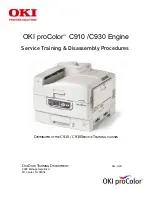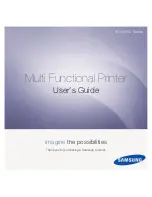
3-140
Chapter 3 Troubleshooting
3. 4. 4. 7 DC330 Component Control (IO Check)
Description
Displays the instruction and the result for the Input Component Check and the Output
Component Check.
• You can monitor the individual Input Component or check operation of the individual Output
Component.
• You can check both multiple Input and multiple Output Components at the same time.
• You can perform a simple batch check for all the Input Component in the appropriate module.
Procedure
1. Select the "IO Check" tab on the Service Mode screen.
2. Select [
DC330
] on the IO Check screen.
3. The Component Control Screen is displayed.
4. Select the desired modules from the Module Selection box or select [Direct Code Input].
• Go to Procedure 6 and the subsequent procedures for selecting [Direct Code Input].
5. Perform Item Check on Output Component and Input Component.
<Output Component Check>
(1) Select an appropriate module from the Specify a Module selection.
(2) The output component names in the selected module are displayed in sequence of
Chain Link No. The status of all the output components shows OFF. (The Input
Component Name table shows a blank display. All the buttons for Input Component
Check show dimmed displays.)
(3) Select the target component and select [Execute] of the Output Component. Or,
select [Cycle] if the output component is capable of performing Cycle operation.
(4) The status display shows "On" or "T-On" if the target components of the Main
Processor are being started normally.
(5) When you want to check several components at the same time, repeat Procedure 5 -
<Output Component Check> from (3) to (4).
(6) If you want to stop checking of the target components being selected, select [Stop]
or select [Stop All] to turn Off all the output components.
(7) Turns Off the corresponding output component at the Main Processor.
(8) Select [Close] to return to the Component Control screen after checking of the
output components has completed.
<Input Component Check>
(1) Select an appropriate module from the Specify a Module selection.
(2) The input component names in the selected module are displayed in sequence of
Chain Link No. The status and No. of Changes of all the input components show
blank display. (The Output Component Name table shows a blank display. All the
buttons for Output Component Check show dimmed displays.
(3) Select the desired components, and select [Execute] of the Input Components.
(4) The status of the target components in the Main Processor "High" or "Low" is
accepted and displayed as "High" or "Low" in the Input Component Status
column."0" is displayed in the No. of Changes column. Emits Beep sounds which
can distinguish the Low from High status.
(5) Changes the On/Off status of the target components to check in the Main Processor.
(6) The PSW updates "High" or "Low" in the Input Component Status column based on
the status of the input component, and emits a Beep sound to tell the difference
between High and Low. +1 is added into the No. of Changes column every time the
"High" or "Low" level changes. (No. of Changes: 0~99)
(7) When you want to check several components at the same time, repeat Step 5 - Input
Component Check from (3) to (4).
[DRIVE] and [Output and Input Components] from the Component selection box have
been selected as the default settings of the Component Control screen.
• Cycle operation: Repeats 1 sec ON and 1 sec OFF in a cyclic.
• The PSW holds information on whether the component is applicable to cycle operation.
• "T-On": The components which are turned On only for a specific period of time, are
automatically turned Off after that.
• If the PSW is instructed to turn On a component which cannot be turned On at the
same time with another component which is already turned On, the component
previously turned On will automatically be turned Off. (Last Precedence Control)
When the component cannot be automatically turned Off, "[!] Unable to check this
component. Stop the other output components." is displayed.
The maximum no. of output components which can be executed at the same time is 12.
At the time when the 12th output component was instructed for execution, selections of
[Execute] and [Cycle] become invalid.
• The input components High/Low sounds are Beep sounds which can distinguish the
Low, High status of the last components instructed to be checked. High sound:
Repeats 125 ms ON, 125 ms OFF, 125 ms ON and 625 ms OFF 3 times. Low
sound: Repeats 500 ms ON and 500 ms OFF 3 times.
• The default of the input components High/Low sounds is set to "ON" (being checked).
The maximum no. of input components which can be checked at the same time is 12.
When the 12th output component was instructed for checking, selection of [Execute]
becomes invalid.
Summary of Contents for DP-C321
Page 4: ...This page is intentionally left blank ...
Page 5: ...Chapter 1 General ...
Page 22: ...1 16 Chapter 1 General 1 3 Type of Paper ...
Page 23: ...1 17 Chapter 1 General ...
Page 24: ...Chapter 2 Maintenance ...
Page 63: ...Chapter 3 Troubleshooting ...
Page 118: ...3 44 Chapter 3 Troubleshooting I F PWB PL9 1 MCU PWB PL13 1 ...
Page 445: ...Chapter 4 Parts List ...
Page 548: ......
















































